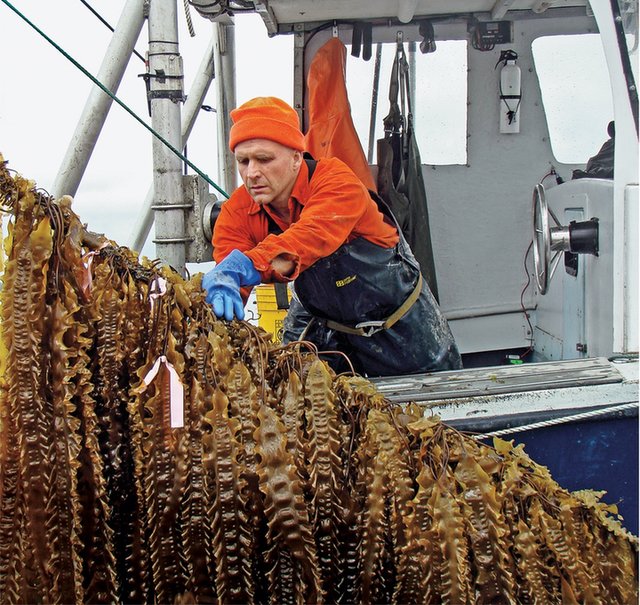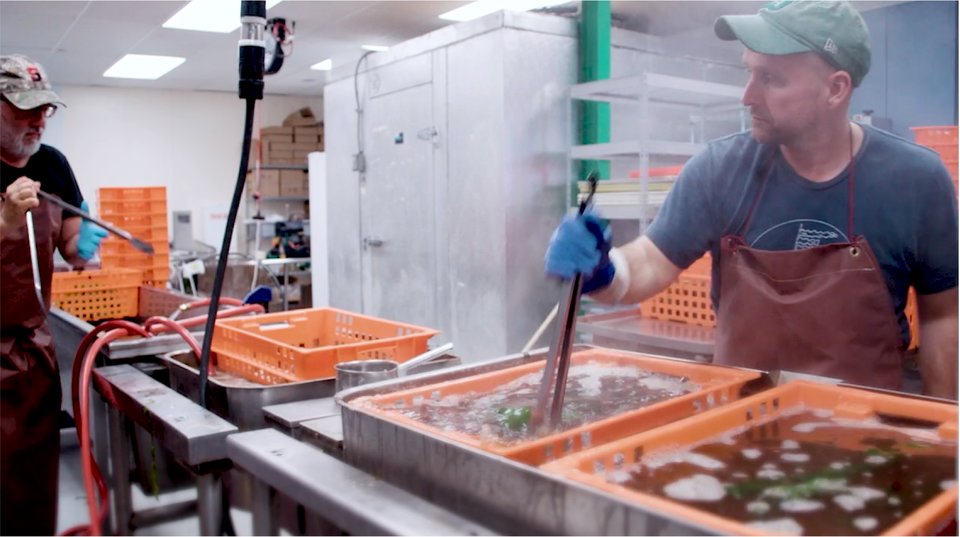TheOcean’sSuperfood
3Doceanfarmsproduceavarietyoffoods,andthat’sterrific.Butthestaroftheshowiskelp.Iftherewaseverasuperfood,kelpis it.
Kelpandotherseaweedsthatpeoplecaneatareincrediblynutritious.Theseseaveggiesarepackedwithvitamins,minerals,andomega-3s.(Omega-3saresomeofthehealthynutrientsthatpeoplegetfromeatingfish.Butyouknowwherefishgetit?Fromeating seaweed!)
Kelphasotheramazingbenefits.It’swhatSmithcallsazero-inputfood.Youdon’thavetoadd,orinput,anythingtoit.Itdoesn’tneedfertilizer,pesticides,orfreshwater.Theoceanandsunlightprovideeverythingkelp needs.
There’smore.Youmayknowthattheburningofcoal,oil,andnaturalgaspumpsalotofcarbondioxide (CO2) intotheair.Allthat CO2leadstochangingclimatesandanoverallwarmingplanet.Alotofthe CO2endsupintheoceanwhereitmakesthewatermoreacidic.It’snotliketheoceanbecomesamegapoolofbubblingacid,butthegreateraciditydoesharmsomewildlife.Shellfish,forexample,growthinner,weaker shells.

Kelprollsarejustoneofmanydishesthataremadewith kelp.

BrenSmithharvestskelpfromhisocean farm.
Seaweedtotherescue!Kelpabsorbs,ortakesin, CO2asitgrows,justlikelandplantsabsorb CO2fromtheair.So,themorekelpthatoceanfarmersgrow,thelessacidictheoceanbecomes.That’sgood news.
Soisthis:Seaweedfarmsareaboosttotheeconomy.Ordersforkelpandotherseaweedsareontheincreasefromrestaurants,schools,companycafeterias,andgrocerystores.Thegrowingdemandmeansmoreandmorepeoplecangetintotheoceanfarmingbusinessandmakeadecent living.
BrenSmithhelpedcreateanorganizationcalledGreenWavetodojustthat.GreenWavetrainspeopleandhelpsthemgetsetupwiththeirownoceanfarms.Itevenguaranteestobuymostoftheircropforthefirsttwoyearssotheyknowthey’llbeabletosellwhatthey grow.
ThousandsofpeoplehavecontactedSmithforhishelp.Infact,he’shadrequeststohelpstart3DfarmsineverycoastalstateintheUnitedStatesandin25countriesaroundtheworld.Wordisspreadingasquicklyaskelp grows!
Okay,sokelpdoesalotofwonderfulthings,butyouprobablyhavebeenaskingyourselfonebigquestion:Howdoesit taste?
TastesLiketheOcean
That’showmostfansofseaveggiesdescribetheflavorofkelpandotherseaweeds.Someoftheseseaveggies,likesugarkelp,areverymild.Theymayhavejustahintofsaltiness,liketheoceanair.Amildflavormakesiteasytoaddkelptoavarietyofdishes,likesoups,salads,beans,rice,mixedvegetables,andpizza.Seaweedsmoothiesareagrowing favorite.
Smithsliceshiskelpintonoodlesandsellsthem.Otherseaweedsaresoldasflakesorpowders,whichcanbesprinkledonanythingfromsoupstopeanutbuttersandwiches,foraboostofflavorand nutrition.
Someseaweedsareabitfishierthansugarkelp,withaflavorclosertotuna.Otherseaweedshaveasavorytaste,likemeatormushrooms.Nomattertheflavor,though,cooksallacrossthelandarediscoveringthatseaweedaddsadelightfultasteoftheoceantotheirfavorite foods.
Goodforfood,goodfortheplanet,goodforbusiness,andfantasticnutrition…Nowonderseaweedistheocean’s supercrop!
abowlofkelpreadyfor eating


